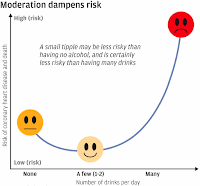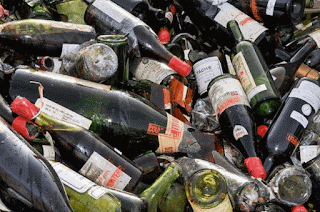The issue is thus that Health risks should be discussed with evidence from all sides: “Alcohol abuse is a serious matter, which deserves a serious discussion. However, any position which aims to stop advancement should provide data to support its conclusion. Doing otherwise does a disservice to everyone involved.”
So, at the moment there are lots of discussions of health and alcohol, some of which I have linked below. Here, I hope to synthesize some of the arguments, in order to clarify them. I have discussed this topic several times before in this blog, over the past couple of years, and I will link to some of those posts below, for further information. Indeed, I have previously asked: Aren’t you sick of hearing about wine and health? Well, my main answer to that is my own viewpoint: A scientist looks at alcohol and health, and is concerned.
My main concern is the explicitly stated WHO claim that alcohol is toxic to the human body: No level of alcohol consumption is safe for our health (“Risks start from the first drop” — Dr. Carina Ferreira-Borges, WHO European Regional Advisor for Alcohol and Illicit Drugs). This is patent nonsense within the biological sciences (my speciality), and so the medical people cannot justifiably claim its inherent veracity. I have introduced the WHO’s situation in: Who started the current WHO completely negative attitude towards alcohol?
The basic issue is that almost everything is toxic to living beings at some concentration, and we need to be told this level, if the information is to be of some practical use to us — some things are toxic even at very low levels, while others do not become toxic until there is a lot of it, and we need to know which is which. Importantly, there are actually two things we need to know. There is usually a level below which the substance has one negative effect on us (“too little”), and another level above which it has a different negative effect (“too much”) — in between is “just right” for continued life.
This applies to everything, not just alcohol, including oxygen and water, which I am sure you agree we really do need to have “just right”. Too little oxygen and we suffer what is called Hypoxemia, and too much oxygen is called Hyperoxia — in between we live to a ripe old age. Too little water is called dehydration, and too much is called drowning — in between we maintain our bodies healthily.
This situation is technically called a J-curve (shown in the next picture), which I have discussed in more detail (with examples) in: A scientist looks at alcohol and health, and is concerned. What concerns me most is that WHO makes no mention of this situation at all — to them, increasing alcohol is increasing danger. * However, science shows that for living organisms there is usually a borderline for most substances — above this line the substance is toxic (ie. can cause disability or death) and below this it has a whole other set of effects.
Well, the same thing is true for what we call “drinking” alcohol, also called ethyl alcohol or ethanol. ** The human body metabolizes it to acetaldehyde (by the chemical process of oxidation), which is what causes the hangover — this is because acetaldehyde is a carcinogen, and poses notably greater toxicity in humans than does ethanol itself. In other words, many of the health hazards in humans typically associated with ethanol consumption can be attributed to acetaldehyde toxicity, rather than to the ethanol itself (see: The effects of alcohol on the human body).
However, acetaldehyde also has the J-curve, where there is a lower limit below which it has no noticeable effect (the body protects itself from any harm by converting the acetaldehyde to acetate, a harmless fatty acid), and an upper limit above which the acetaldehyde turns nasty on us. So, if we keep our intake below the latter level, then we are fine. This is very important for a very practical reason: acetaldehyde occurs in all sorts of things that we treat as regular foodstuffs. Indeed, Lewis Perdue (who founded Wine Industry Insight, and ran its News Fetch newsletter) has pointed out (The hidden hitches in Dry January/Mediterranean diet plans) just how long this list is, including: apples, coffee, cheese, yogurt, chicken, green tea ...
You should definitely read that linked article,*** because the list of what we consider to be perfectly normal (safe) foods, but which contain acetaldehyde, is impressively long. An abbreviated version is also available at: Lewis Perdue’s analysis of Dry January & alcohol cancer claims:
Why Lewis Perdue believes cancer links to alcohol are over stated. If you are in the midst of Dry January here is a sobering analysis by US wine and medical writer, Lewis Perdue, into the scientific and medical research and health claims made by certain US government regulators and alcohol control organisations about how damaging drinking alcohol is and in particular the supposed threat of the acetaldehyde compound commonly found in alcohol beverages that is claimed to be linked to cancer. Research and evidence that Perdue believes is far from proven.The basic point here is that a normal Mediterranean diet contains alcohol, especially with meals. People have been living on this diet for many centuries, but only by controlling their alcohol intake, and consuming it mostly with food. This topic is discussed in more detail in: Underrated aspects of a true Mediterranean diet.
For most of us, however, there is a catch, as pointed out in that last article:
Most existing research on the health effects of alcohol has been conducted in populations outside the Mediterranean region, where drinking patterns differ significantly from those of the traditional Mediterranean diet. Therefore, future studies are needed to investigate the impact of different drinking occasions and patterns more precisely. These studies could provide a clearer scientific basis for recommendations on alcohol consumption, balancing the need for caution against potential benefits when consumed moderately or as part of meals.Sadly, doing proper scientific experiments (what is technically called: A Randomized Control Study) is difficult on humans, especially with regard to human behavior. This is because we cannot properly control what the people taking part in the experiment actually do, day by day (see: The fight over moderate drinking: why studies on effects are unlikely to happen). So, most experiments rely on self-reported behavior by the people involved, which is a poor substitute (see, as an example: Why are older Americans drinking so much?). Technically speaking, the studies thus confuse cause with correlation (as done, for example, by the American College of Physicians, in their current policy brief: Excessive Alcohol Use and Alcohol Use Disorders).
It is sometimes argued that Health risks should be discussed with evidence from all sides, but it is actually best to focus only on the best experiments. I have contributed a few posts of my own on this topic:
- The alleged health benefits of wine depend on who funded the research
- Wine and health — why is there so much argument, pro and con?
- Why we are never going to know whether wine is good for us, or not
- Wine and health is never a simple topic
- Health and the wine drinker, yet again
The bottom line, however, is the increasing negative societal attitude (Is wine heading for an iceberg?), just like the lead-up to Prohibition exactly a hundred years ago in the USA (1920–1933) (How neo-prohibitionists came to shape alcohol policy). In practice, this is leading to the requirement for containers of beer, wine and liquor sold to have cancer-warning labels (Should alcoholic beverages have cancer warning labels?). Ireland, for example, will require them starting in 2026.
This places alcohol in the same position as tobacco (Is wine the “2024 cigarette”? Younger generations say all alcohol is ‘literally poison’), which I have discussed before (Is consuming wine really as unhealthy as tobacco?). Next, they will presumably put these warnings on the sun, which is far and away the biggest cause of skin cancer, especially in places like Australia (where I grew up, and had my first skin cancer removed at age 27).
There are none so blind as those who will not see. The so-called “sober curious” are currently not seeing very much. Even the national liquor chain here in Sweden is getting in on the act: “alcohol consumption in Sweden fell during the past year, by 2.7 percent. It is a positive trend that benefits public health”.
* For a discussion of the WHO and their failure to ever mention the J-curve, see: Wine and health: challenging the ‘no safe level’ claims.
** Wine contains many chemicals, of course; see: The effect of red wine is different from white: did you know that?
*** Disclosure: I made a small contribution to this web page.
















